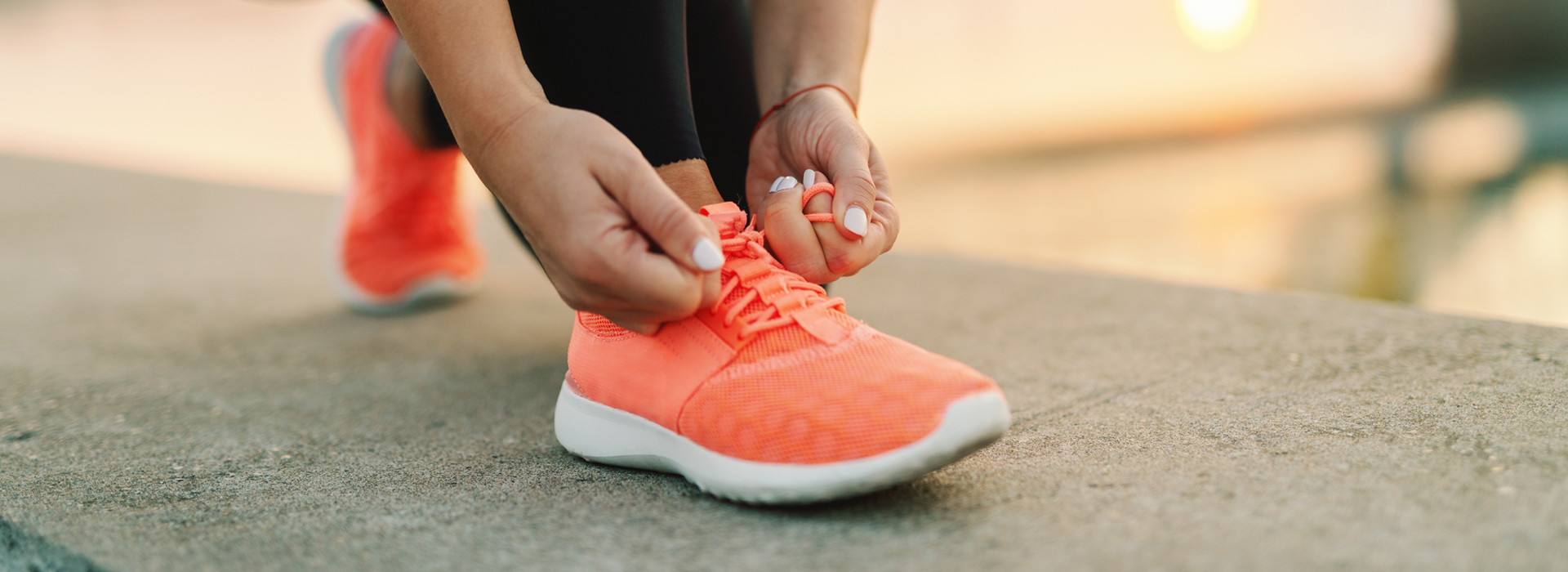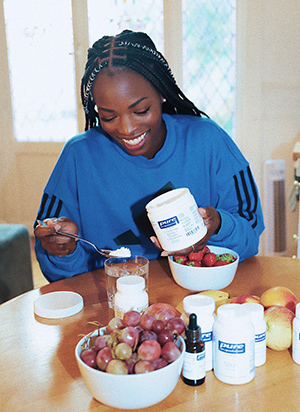
The Benefits of Type II Collagen for Joint Health
Collagen is the most abundant protein found in the human body. It is a foundation of support for your connective tissues. There are many types of collagen in the body, but type II collagen specifically impacts your joint health.
Along with normal wear and tear, the production of collagen drops as you age. This reduction impacts the health of your joints and even your ability to heal from injuries. 1
As a result, the interest in type II collagen supplementation continues to grow. Intake of type II collagen may help maintain the body’s collagen levels, making it an ideal supplement to support joint health and mobility.
What is collagen?
Collagen is found all over the body, where it provides structure, foundation, cushion, and support to connective tissue.2 It is a strong protein(often described as strong as steel)that forms flexible connective tissues throughout the body, such as skin and cartilage.
It acts as a foundation of support, providing strength and elasticity to the skin, ligaments, tendons, cartilage, and other tissues.
There are more than sixteen types of collagen in your body, but type II collagen is the most critical type for your joint health. 2
What is type II collagen?
Type II collagen is found in the lining of joints. It is the most common type found in cartilage and synovial fluid, which lubricates our joints.3 Aside from your cartilage, it’s also found in your eyes and spinal cord.
Hyaline cartilage, the most common type of cartilage found at the ends of your bones in the joints and ribs, is made up of type II collagen.4 Cartilage is key for shock absorption for your joints, as well as strength and flexibility. It keeps your joints supple and able to bounce back from impact. 5
As mentioned, type II collagen naturally decreases with age. It’s also impacted by normal wear and tear, especially with overuse.3 Certain joint-related health conditions canal so cause symptoms of discomfort, stiffness, or swelling that affect joint function and can even lead to irreversible joint damage. However, supplementing with type II collagen may help improve symptoms and support a better quality of life.
How can type II collagen supplementation help your joints?
Inflammation is a normal part of the body’s healing process. If you have an injury, inflammatory molecules in the body respond quickly to recruit the immune cells needed for repair. 6
However, in certain situations, as seen with many joint conditions, the inflammatory signals stay on without a return to a normal, healthy state of balance in the body. This upregulation of the inflammatory immune response can lead to discomfort, swelling, stiffness, and even a loss of structural integrity in your joints.
Supplementing with type II collagen may provide relief from occasional discomfort caused by a wide range of conditions that cause inflammation in the area around a joint. Supplemental collagen has been well studied for its contributions to joint health.

Joint discomfort
In a joint health study of more than 400 people, type II collagen supplementation helped support improvements in occasional discomfort, swelling, stiffness, and joint function. 7
Similar results have been seen in other studies that focused primarily on knee function and discomfort. One smaller study found that collagen supplementation supported healthy joint function and mobility that impacted a person’s ability to participate in daily activities.8 And yet another study found that type II collagen supplements helped with knee discomfort and stiffness.9It also helped participants walk or stand for more extended periods before they felt soreness.
Joint repair
Beyond supporting the symptoms of occasional joint discomfort, type II collagen supplements may support increases in chondrocytes. Chondrocytes are the cells responsible for the formation of cartilage.10 This may be one way type II collagen can help repair cartilage loss at sites where it has been worn away by the progression of certain joint conditions.
One study found that collagen helped improve knee range of motion and allowed the subjects to exercise longer before noting any discomfort.11 Another study examining healthy, physically active individuals resulted in improvements in joint function and comfort. 12
Can you get type II collagen from food in your diet?
Food sources of type II collagen include bone broth, gelatin, fish with the skin, and other animal proteins. However, these food sources typically don’t provide enough to be considered a significant source for joint health support.
Supplemental type II collagen usually comes in two forms: undenatured or hydrolyzed. Undenatured means that the collagen remains intact, which appears to be more effective for joint health than denatured collagen that has been broken down until smaller units.13 Hydrolyzed means that the collagen has been slightly broken down to support absorption but still provides benefit.14
Type II collagen can be taken either orally or topically, depending on what type of support you are looking for and how it affects your joints. The supplement comes in a variety of forms, including capsules, tablets, or powders you can add to smoothies or shakes

Type II collagen to support the body’s healing process
Type II collagen may help you maintain healthy joints as you age while addressing any discomfort. If you’re looking for a natural way to support your joint health, it may be worth considering type II collagen supplements into your daily routine to promote joint health over time.
It is worth noting that these supplements should be used in combination with other treatment options as directed by your health care practitioner; however, based on the research adding them can be an effective way to support your body’s natural healing properties.
1 Varani, James, Michael K. Dame, Laure Rittie, Suzanne E.G. Fligiel, SewonKang, Gary J. Fisher, and John J. Voorhees. “Decreased Collagen Production in Chronologically Aged Skin.” The American Journal of Pathology168, no. 6 (June 2006): 1861–68. https://doi.org/10.2353/ajpath.2006.051302.
2 Lodish, Harvey, Arnold Berk, S. Lawrence Zipursky, Paul Matsudaira, David Baltimore, and James Darnell. “Collagen: The Fibrous Proteins of the Matrix.” Molecular Cell Biology. 4th Edition, 2000. https://www.ncbi.nlm.nih.gov/books/NBK21582/.
3 Poole, A. R., M. Kobayashi, T. Yasuda, S. Laverty, F. Mwale, T. Kojima, T. Sakai, et al. 61, no. suppl 2 (November 1, 2002): ii78–81. https://doi.org/10.1136/ard.61.suppl_2.ii78.
4 Miosge, Nicolai, Michael Hartmann, Cyrilla Maelicke, and Rainer Herken. Histochemistry and Cell Biology122, no. 3 (September 1, 2004): 229–36. https://doi.org/10.1007/s00418-004-0697-6.
5 Encyclopedia Britannica. “Cartilage | Description, Anatomy, & Function.” Accessed June 13, 2021. https://www.britannica.com/science/cartilage.
6 Koh, Timothy J., and Luisa Ann DiPietro. “Inflammation and Wound Healing: The Role of the Macrophage.” Expert Reviews in Molecular Medicine13 (July 11, 2011): e23. https://doi.org/10.1017/S1462399411001943.
7 Wei, Wei, Ling-Ling Zhang, Jian-Hua Xu, Feng Xiao, Chun-De Bao, Li-Qing Ni, Xing-Fu Li, et al. 11, no. 6 (December 1, 2009): R180. https://doi.org/10.1186/ar2870.
8 Bakilan, Fulya, Onur Armagan, Merih Ozgen, Funda Tascioglu, Ozge Bolluk, and Ozkan Alatas. The Eurasian Journal of Medicine48, no. 2 (June 2016): 95–101. https://doi.org/10.5152/eurasianjmed.2015.15030.
9 Lugo, James P., Zainulabedin M. Saiyed, and Nancy E. Lane. Nutrition Journal15, no. 1 (January 29, 2016): 14. https://doi.org/10.1186/s12937-016-0130-8.
10 Akkiraju, Hemanth, and Anja Nohe. Journal of Developmental Biology3, no. 4 (December 2015): 177–92. https://doi.org/10.3390/jdb3040177.
11 Lugo, James P., Zainulabedin M. Saiyed, Francis C. Lau, Jhanna Pamela L. Molina, Michael N. Pakdaman, Arya Nick Shamie, and Jay K. Udani. “Undenatured Type II Collagen (UC-II®) for Joint Support: A Randomized, Double-Blind, Placebo-Controlled Study in Healthy Volunteers.” Journal of the International Society of Sports Nutrition10, no. 1 (October 24, 2013): 48. https://doi.org/10.1186/1550-2783-10-48.
12 Lopez, Hector L., Tim N. Ziegenfuss, and Joosang Park. “Evaluation of the Effects of BioCell Collagen, a Novel Cartilage Extract, on Connective Tissue Support and Functional Recovery From Exercise.” Integrative Medicine: A Clinician’s Journal14, no. 3 (June 2015): 30–38.
13 Marone, Palma Ann, Francis C. Lau, Ramesh C. Gupta, Manashi Bagchi, and Debasis Bagchi. “Safety and Toxicological Evaluation of Undenatured Type II Collagen.” Toxicology Mechanisms and Methods20, no. 4 (May 2010): 175–89. https://doi.org/10.3109/15376511003646440.
14 Benito-Ruiz, P., M. M. Camacho-Zambrano, J. N. Carrillo-Arcentales, M. A. Mestanza-Peralta, C. A. Vallejo-Flores, S. V. Vargas-López, R. A. Villacís-Tamayo, and L. A. Zurita-Gavilanes. “A Randomized Controlled Trial on the Efficacy and Safety of a Food Ingredient, Collagen Hydrolysate, for Improving Joint Comfort.” International Journal of Food Sciences and Nutrition60 Suppl 2 (2009): 99–113. https://doi.org/10.1080/09637480802498820.


 Facebook
Facebook Instagram
Instagram